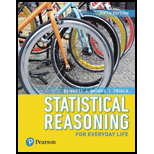
One of Mendel’s famous genetics experiments yielded 580 peas, with 428 of them green and 152 yellow.
- a. What single value is the best estimate of the population proportion of yellow peas?
- b. Use the sample results to construct a 95% confidence interval for the estimate of the population proportion of yellow peas.
- c. What is the margin of error?
- d. Write a statement that correctly interprets the confidence interval found in part (b).
- e. The sample proportion of 0.262 was obtained from one specific sample of 580 peas. Suppose many different samples of 580 peas are obtained and the sample proportion is found for each sample. What do we know about the shape of the distribution of the sample proportions?
- f. Assume that we plan to conduct another genetics experiment to determine the proportion of peas that are green. How many sample peas would be needed in order to have 95% confidence that the margin of error is 0.04?
a.
Identify the single value to estimate the population proportion of yellow peas.
Answer to Problem 1CRE
The population proportion of yellow peas is best estimated by sample proportion, 0.262.
Explanation of Solution
In a research of 580 peas by Mendel, 428 were found to be green peas and 152 found to be yellow peas.
The sample proportion is calculated from a sample that has been taken from a larger population.
It is known that the sample proportion is an unbiased estimator of the population proportion. In this context, the researcher has only one sample of 1,708 adults drawn from the population and its proportion has been calculated.
The proportion of yellow peas is estimated by the sample proportion.
Denote x as and the number of yellow peas.
The sample proportion is:
Substituting the corresponding values to get the sample proportion,
Thus, the sample proportion is 0.262.
Thus, the proportion of yellow peas is best estimated by sample proportion, 0.262.
b.
Obtain the 95% confidence interval to estimate the proportion of yellow peas.
Answer to Problem 1CRE
The 95% confidence interval to estimate the proportion of yellow peas is
Explanation of Solution
Calculation:
Margin of error:
The margin of error for the estimate of population proportion,
Where, n be the sample size, E be the margin of error and
Substitute the corresponding values to get the margin of error,
Thus, the margin of error is 0.036.
The 95% confidence interval is:
Where, E be the margin of error and
Substitute the corresponding values to get confidence interval,
Thus, the 95% confidence interval to estimate the proportion of yellow peas is
c.
Find the margin of error.
Answer to Problem 1CRE
The margin of error is 0.036.
Explanation of Solution
From the previous part (b), it is observed that the calculated margin of error is 0.036.
Thus, the margin of error is 0.036.
d.
Interpret the 95% confidence interval obtained in part (b).
Explanation of Solution
From part (a), the obtained 95% confidence interval is
Thus, one can be 95% confident that the population proportion of yellow peas will be between 0.226 and 0.298.
e.
Identify the shape of the distribution of the sample proportions.
Answer to Problem 1CRE
The approximate shape of the distribution of the sample proportions is bell-shaped.
Explanation of Solution
It is given that the sample proportion is 0.262, for the particular sample of 580 peas. For the different samples of 580 peas, the corresponding sample proportions are calculated.
The distribution of the sample proportion is referred to the distribution of the proportion of the sample of given size.
Here, the many samples of size 580 are selected from the population of peas. By Central Limit Theorem, the distribution of the sample proportion is assumed to be approximately normal.
Thus, it is assumed that the shape of the distribution of the sample means will be approximately symmetric or bell-shaped.
f.
Obtain number of peas needed to be surveyed to estimate the population proportion of peas with 95% confidence, so that the sample proportion will have the margin error of 0.04.
Answer to Problem 1CRE
The number of peas needed to be surveyed to estimate the population proportion of peas with 95% confidence, so that the sample proportion will have the margin error of 0.04 is at least 625.
Explanation of Solution
Calculation:
It is given that the margin of error is
Margin of error:
The approximate formula for the margin of error for the 95% confidence interval is:
Where, n be the number of samples, E be the margin of error.
Substitute the corresponding values to get the sample size,
Thus, the sample size is at least 625.
Therefore, the number of peas needed to be surveyed to estimate the population proportion of peas with 95% confidence, so that the sample proportion will have the margin error of 0.04 is at least 625.
Want to see more full solutions like this?
Chapter 8 Solutions
Statistical Reasoning for Everyday Life (5th Edition)
 Glencoe Algebra 1, Student Edition, 9780079039897...AlgebraISBN:9780079039897Author:CarterPublisher:McGraw Hill
Glencoe Algebra 1, Student Edition, 9780079039897...AlgebraISBN:9780079039897Author:CarterPublisher:McGraw Hill College Algebra (MindTap Course List)AlgebraISBN:9781305652231Author:R. David Gustafson, Jeff HughesPublisher:Cengage Learning
College Algebra (MindTap Course List)AlgebraISBN:9781305652231Author:R. David Gustafson, Jeff HughesPublisher:Cengage Learning

